Grade I listed buildings in Monmouthshire
Monmouthshire is a county and principal area of Wales. It borders Torfaen and Newport to the west; Herefordshire and Gloucestershire (in England) to the east; and Powys to the north. The largest town is Abergavenny, with other large towns comprising Chepstow, Monmouth, and Usk.[1] The present county was formed under the Local Government (Wales) Act 1994, and comprises some sixty percent of the historic county.[2] Between 1974 and 1996, the county was known by the ancient title of Gwent,[3] recalling the medieval Welsh kingdom.[4] The county is 850 km2 (330 sq mi) in extent,[5] with a population of 93,600.[6]

In the United Kingdom, the term "listed building" refers to a building or other structure officially designated as being of special architectural, historical or cultural significance. Listing was begun by a provision in the Town and Country Planning Act 1947. Once a building is listed, strict limitations are imposed on the modifications allowed to its structure or fittings. In Wales,[7] authority for listing under the Planning (Listed Buildings and Conservation Areas) Act 1990 lies with Cadw.[8] Listed buildings are categorised into three grades:
- Grade I – buildings of exceptional interest, only 2.5% of listed buildings in England and Wales are Grade I;
- Grade II* – buildings of particular importance with more than special interest, 5.8% of listed buildings in England and Wales are Grade II*;
- Grade II – buildings of special interest; 91.7% of all listed buildings in England and Wales are in this class.[9]
There are 53 Grade I listed buildings in Monmouthshire.[note 1][10] These consist of twenty-four churches, a priory and an abbey, eight castles, seven houses, two bridges, a barn, a cross, a farm, a folly, a gatehouse, a hotel, a municipal building, a stables, and two elements of town walls. The journalist Simon Jenkins notes the county's "fine collection" of castles,[11] mostly dating from the Norman invasion of Wales, and describes Chepstow as "the glory of medieval south Wales".[12] The castle at Raglan is later, dating from the mid-fifteenth century.[13] The fortified bridge over the River Monnow at Monmouth is the only remaining fortified river bridge in the country with its gate tower standing on the bridge, and has been described as "arguably the finest surviving medieval bridge in Britain".[14] Monmouthshire has a more "modest"[11] range of churches, although that at Bettws Newydd has "perhaps the most complete rood arrangement remaining in any church in England and Wales".[15] The county's Grade I listed abbey, at Tintern, became a focal point of the Wye Tour[16] in the late-eighteenth century.[17] The Monmouthshire writer and artist, Fred Hando, chronicled the history of the county in some 800 newspaper articles written between the 1920s and the 1960s and published in the South Wales Argus, focusing on "the little places of a shy county".[18] Among the Grade I listed structures Hando described were "the tallest house in Monmouthshire" at Treowen,[19] "the most crooked church in Britain" at Cwmyoy,[20] and the Arts and Crafts sgraffito at Llanfair Kilgeddin.[21]
Notable people associated with Monmouthshire's Grade I listed buildings include Henry V, born at Monmouth Castle in 1387;[22] the medieval soldier and statesman William Marshal, 1st Earl of Pembroke, who undertook major construction at Chepstow Castle;[23] and Henry Somerset, 1st Marquess of Worcester, who entertained his king at Raglan, and lost the castle at the end of the First English Civil War.[24] William Wordsworth undertook the Wye Tour in 1798, composing Lines Written a Few Miles above Tintern Abbey during his visit,[25] and Walter Savage Landor sought, unsuccessfully, to establish a landed estate at Llanthony Priory.[26] Archdeacon Coxe's record of his journey to Llanthony in the spring of 1799 provides an illustration of the hazards of travelling in Wales at this time: "I would not recommend timid persons to pass this way in a carriage, for in the whole course of my travels, I seldom met with one more inconvenient and unsafe".[27] In 1840, the Chartist leader John Frost and two colleagues were tried at the Shire Hall in Monmouth and sentenced to be hanged, drawn and quartered, the last such sentences to be passed in Britain.[note 2][28] A statue in front of the Shire Hall commemorates Charles Stewart Rolls, the aviator and entrepreneur who was the first Briton to be killed in a plane crash.[29]
The architecture of the county was first systematically covered by William Coxe in his two-volume, An Historical Tour in Monmouthshire, published in 1801. Coxe's Preface explains the Tour's genesis; "The present work owes its origin to an accidental excursion in Monmouthshire, in company with my friend Sir Richard Hoare, during the autumn of 1798. I was struck with the picturesque ruins of ancient castles, and I was animated with the view of mansions distinguished by the residence of illustrious persons".[30] A detailed county history was undertaken by Sir Joseph Bradney, in his A History of Monmouthshire from the Coming of the Normans into Wales down to the Present Time; published in the early 20th century.[31] More recent studies include those of the architectural historian John Newman, in his Gwent/Monmouthshire volume of the Pevsner Buildings of Wales series; and, most exhaustively, by Sir Cyril Fox and Lord Raglan, in their three-volume study, Monmouthshire Houses.[32] The last was described by the architectural historian Peter Smith as "one of the most remarkable studies of vernacular architecture yet made in the British Isles,[33] a landmark, in its own field, as significant as Darwin's Origin of Species".[34]
Buildings
| Name | Location | Date Listed | Grid Ref.[note 3] Geo-coordinates |
Function | Notes | Reference Number | Image |
|---|---|---|---|---|---|---|---|
| Abbey Hotel | Llanthony | 9 January 1956 | SO2883227873 51°56′41″N 3°02′12″W |
Commercial | Built into the west range of Llanthony Priory[35] | 1940 |  |
| Abergavenny Castle | Abergavenny | 7 May 1952 | SO2994413962 51°49′12″N 3°01′04″W |
Castle | West of the main road on the southern approach to the town centre[36] | 2376 |  |
| Court Farm Barn | Llanthony | 9 January 1956 | SO2870227868 51°56′41″N 3°02′19″W |
Barn | On the west side of the Llanthony Priory precinct about 110m from the priory ruins[37] | 1941 | 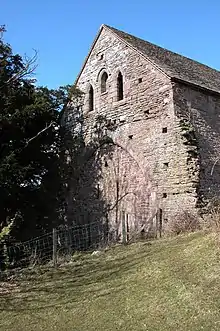 |
| Caldicot Castle | Caldicot | 6 October 1953 | ST4867988516 51°35′35″N 2°44′32″W |
Castle | About 300m east of the Church of St Mary and about 700m east of Caldicot[38] | 2006 | 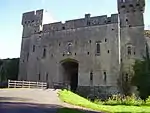 |
| Castle House | Usk | 16 February 1953 | SO3775301088 51°42′18″N 2°54′08″W |
House | On a hillside a little north east of Usk town centre and below the castle[39] | 2128 | 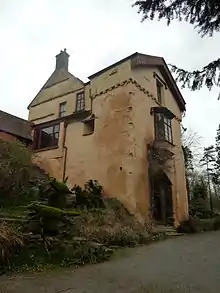 |
| Chepstow Castle | Chepstow | 12 June 1950 | ST5333094113 51°38′38″N 2°40′33″W |
Castle | In a commanding position on the west bank of the River Wye[40] | 2475 |  |
| Church of St Aeddan | Bettws Newydd | 9 January 1956 | SO3622305874 51°44′53″N 2°55′31″W |
Church | At the south east end of the village, approached by lane running east, just to the north of Bettws Lodge[41] | 1962 |  |
| Church of St Bridget | Skenfrith | 19 November 1953 | SO4560920340 51°52′44″N 2°47′30″W |
Church | Towards the north end of Skenfrith village and approximately 100m north west of Skenfrith Castle[42] | 2082 | 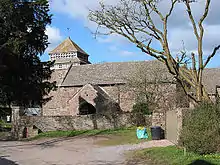 |
| Church of St Cadoc | Llangattock Lingoed | 9 January 1956 | SO3615220064 51°52′32″N 2°55′44″W |
Church | In a sloping churchyard, in the centre of Llangattock Lingoed[43] | 1955 | 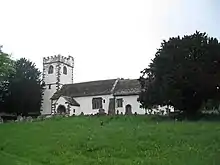 |
| Church of St David | Llangeview | 18 November 1980 | SO3968300694 51°42′06″N 2°52′27″W |
Church | In a rounded churchyard overlooking the A449 Usk exit, reached via lane running south from the B4235 just east of the bridge over the A449[44] | 2711 | 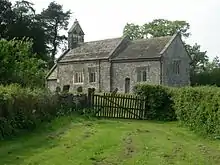 |
| Church of St David | Llanthony | 9 January 1956 | SO2884927820 51°56′40″N 3°02′12″W |
Church | 50m south of the priory buildings at Llanthony[45] | 1938 | 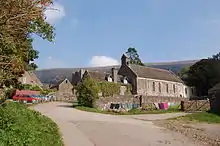 |
| Church of St Jerome | Llangwm | 19 August 1955 | SO4329000557 51°42′03″N 2°49′19″W |
Church | Some 500m east of Llangwm Isaf church, in an isolated site[46] | 2028 | 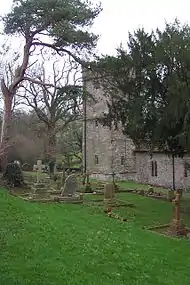 |
| Church of St John | Llandenny | 27 November 1953 | SO4151203923 51°43′52″N 2°50′54″W |
Church | In the centre of the village of Llandenny, in an elevated position within an enclosed churchyard[47] | 17425 | 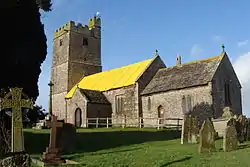 |
| Church of St Martin | Cwmyoy | 9 January 1956 | SO2990523354 51°54′16″N 3°01′13″W |
Church | In the centre of Cwmyoy village on the east slope of the Vale of Ewyas[48] | 1933 | 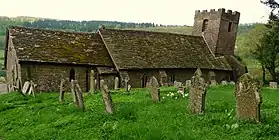 |
| Church of St Mary | Abergavenny | 7 May 1952 | SO3010114136 51°49′17″N 3°00′56″W |
Church | Key building in the group of historic buildings close to the main commercial centre of Abergavenny[49] | 2373 |  |
| Church of St Mary | Caldicot | 19 August 1955 | ST4831688629 51°35′39″N 2°44′51″W |
Church | About 400m north east of the centre of Caldicot village[50] | 2019 | 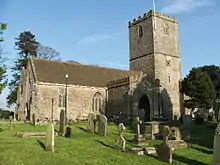 |
| Church of St Mary | Chepstow | 12 June 1950 | ST5359493973 51°38′34″N 2°40′19″W |
Church | At the end of the street within a churchyard crossed by a walkway to Lower Church Street[51] | 2594 |  |
| Church of St Mary the Virgin | Llanfair Kilgeddin | 9 January 1956 | SO3558708684 51°46′23″N 2°56′06″W |
Church | Close to the river Usk 1.5 km (0.93 mi) north east of Pant-y-goitre[52] | 2782 | 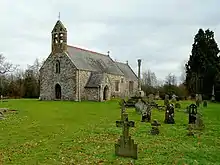 |
| Church of St Mary | Magor | 1 March 1963 | ST4252986980 51°34′44″N 2°49′51″W |
Church | In the centre of the village and reached off Magor Square[53] | 2928 |  |
| Church of St Mary | Portskewett | 19 August 1955 | ST4988888107 51°35′23″N 2°43′29″W |
Church | In the centre of Portskewett village at the junction of Main Road and Sudbrook Road[54] | 2044 |  |
| Church of St Michael and All Angels | Gwernesney | 18 November 1980 | SO4148901805 51°42′43″N 2°50′54″W |
Church | Some 2 km (1.2 mi) east north east of the Usk junction of the A449, just north of the B4235[55] | 2715 | 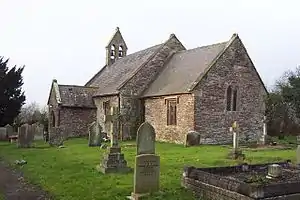 |
| Church of St Nicholas | Grosmont | 9 January 1956 | SO4047624300 51°54′51″N 2°52′00″W |
Church | In the centre of Grosmont in a large churchyard[56] | 1947 |  |
| Church of St Nicholas | Trellech | 19 November 1953 | SO5004305486 51°44′45″N 2°43′30″W |
Church | Prominently sited in the centre of Trellech[57] | 2106 |  |
| Church of St Peter, St Paul and St John | Llantrisant | 18 November 1980 | ST3912196924 51°40′04″N 2°52′54″W |
Church | In the centre of Llantrissent[58] | 2718 |  |
| Church of St Teilo | Llantilio Crossenny | 19 November 1953 | SO3988814983 51°49′49″N 2°52′25″W |
Church | In a churchyard in the centre of Llantilio Crossenny[59] | 2073 |  |
| Church of St Teilo | Llantilio Pertholey | 9 January 1956 | SO3115216336 51°50′29″N 3°00′03″W |
Church | Just off the old Hereford road about 3 km (1.9 mi) north of Abergavenny[60] | 2002 |  |
| Church of St Tewdric | Mathern | 19 August 1955 | ST5231390881 51°36′53″N 2°41′24″W |
Church | In the centre of Mathern[61] | 2040 |  |
| Church of St Tysoi | Llansoy | 19 August 1955 | SO4421902396 51°43′03″N 2°48′32″W |
Church | At the southern end of Llansoy about 250m south of the junction with the main road[62] | 2029 | 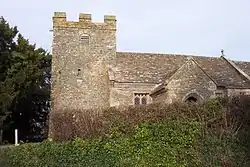 |
| Clytha Castle | Llanarth | 9 January 1956 | SO3639008390 51°46′14″N 2°55′24″W |
Folly | On a hillside south of Clytha Park off the old A40 road some 300m east of the gates to the park[63] | 1968 |  |
| Clytha Park | Llanarth | 9 January 1956 | SO3667109025 51°46′35″N 2°55′09″W |
House | In a landscaped park north of the old A40 reached via a drive from the entrance opposite the junction with the road to Bettws Newydd[64] | 1966 | 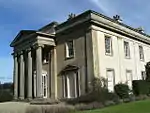 |
| Cross at Croes Lwyd | Raglan | 31 January 2001 | SO4005306992 51°45′30″N 2°52′12″W |
Cross | On the southern side of Broom Lane about 400m east of Broom House, at the bottom of the garden at Whitecross Cottage[65] | 24716 | 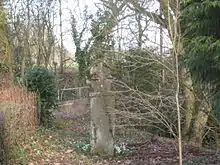 |
| Great Castle House | Monmouth | 15 August 1974 | SO5070912915 51°48′46″N 2°42′59″W |
House | In the castle enclosure at the highest point of the town and just north of the town square[66] | 2217 | 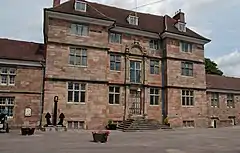 |
| Grosmont Castle | Grosmont | 9 January 1956 | SO4053224454 51°54′56″N 2°51′58″W |
Castle | On a flat elevated plateau, some 100m north west of Grosmont village, approached along a narrow lane from the main street[67] | 1949 |  |
| Llanthony Priory | Llanthony | 9 January 1956 | SO2885427872 51°56′41″N 3°02′11″W |
Church | In Llanthony village in the Vale of Eywas[68] | 1939 | 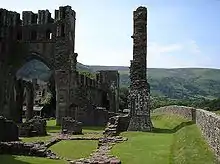 |
| Llanvihangel Court | Llanvihangel Crucorney | 6 May 1952 | SO3278120411 51°52′42″N 2°58′40″W |
House | In Llanvihangel Crucorney about 400m south east of the Church of St Michael[69] | 1919 | 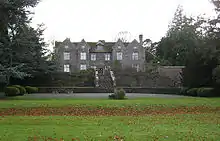 |
| Llanvihangel Court Stable Block | Llanvihangel Crucorney | 29 January 1998 | SO3279420362 51°52′40″N 2°58′40″W |
Stables | About 30m south of Llanvihangel Court[70] | 19288 |  |
| Llwyn-celyn Farmhouse | Llanvihangel Crucorney | 9 January 1956 | SO3095021807 51°53′26″N 3°00′17″W |
Farmhouse | On a knoll on the west side of Stanton about 1.5 km (0.93 mi) north west of Llanvihangel Crucorney[71] | 1937 | 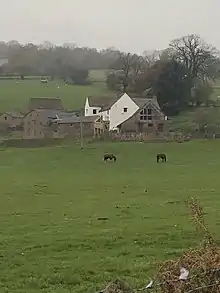 |
| Mathern Palace | Mathern | 6 October 1953 | ST5229090821 51°36′51″N 2°41′26″W |
House | In the centre of Mathern village about 50m south west of the Church of St Tewdric[72] | 2007 | 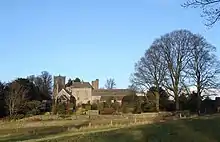 |
| Monmouth Castle | Monmouth | 15 August 1974 | SO5067512872 51°48′44″N 2°43′01″W |
Castle | On the east bank of the River Monnow at the highest point of the town and just north of the town square[73] | 2216 | 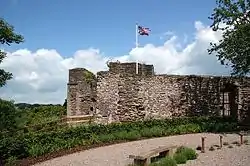 |
| Monnow Bridge | Monmouth | 15 August 1974 | SO5046012508 51°48′32″N 2°43′12″W |
Bridge | At the entrance to Monmouth's principal commercial street which leads up the hill to the town square from the south-west[74] | 2218 | 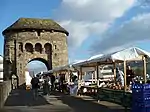 |
| Pen-y-Clawdd Court | Llanvihangel Crucorney | 6 May 1952 | SO3103020099 51°52′31″N 3°00′12″W |
House | About 1500m south west of the Church of St Michael, Llanvihangel Crucorney approached by a lane from the small settlement round the old Llanvihangel station[75] | 1926 | 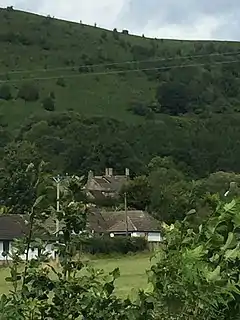 |
| Penallt Old Church | Penallt | 19 November 1953 | SO5219810732 51°47′36″N 2°41′40″W |
Church | In the very northernmost corner of Trellech Community about 1000m south of Monmouth, on the B4239 road at the junction by High Glanau[76] | 2104 | 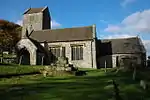 |
| Port Wall | Chepstow | 24 March 1975 | ST5325993947 51°38′33″N 2°40′37″W |
Walls, railings, gates | Extending from near Chepstow Castle, uphill to the town gate and crossing to the quarry above the station[77] | 2477 | 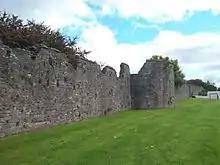 |
| St Mary's Priory Church | Usk | 1 April 1974 | SO3789200811 51°42′09″N 2°54′01″W |
Church | A town centre church, just south of the main thoroughfare with a large walled churchyard[78] | 2123 |  |
| Priory Gatehouse | Usk | 16 February 1953 | SO3783600795 51°42′09″N 2°54′03″W |
Gatehouse | At right angles to the churchyard entrance, on a corner site, facing up Priory Street to Twyn Square[79] | 2126 | 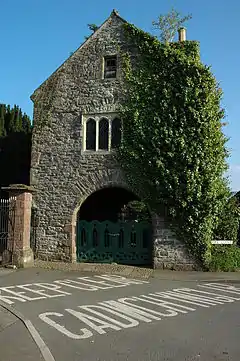 |
| Raglan Castle | Raglan | 19 November 1953 | SO4143308324 51°46′14″N 2°51′01″W |
Castle | Magnificently sited 0.25 km (0.16 mi) north of Raglan and reached by a private drive from the A40[80] | 2101 |  |
| Old Wye Bridge | Chepstow | 24 March 1975 | ST5361094359 51°38′46″N 2°40′19″W |
Bridge | Continuing the line of Bridge Street. Aligned almost due north/south, crossing a bend in the River Wye, here the boundary between Wales and England. The north part of the bridge is in England[81] | 2479 | 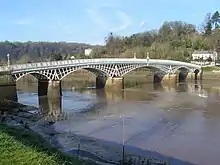 |
| Shire Hall | Monmouth | 27 June 1952 | SO5078012837 51°48′43″N 2°42′55″W |
Shire Hall | In the town square in the centre of Monmouth with a cobbled area to the front and sides spreading as far as the line of the road and including the statue of Charles Stewart Rolls, the co-founder of Rolls-Royce[82] | 2228 | 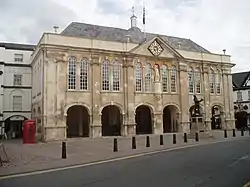 |
| Tintern Abbey | Tintern | 29 September 2000 | SO5329100037 51°41′50″N 2°40′38″W |
Church | In a prominent position on the right bank of the river Wye on the east side of the A466[83] | 24037 | 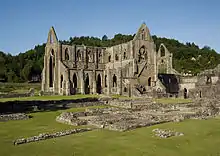 |
| Town Gate | Chepstow | 6 December 1950 | ST5327993793 51°38′28″N 2°40′36″W |
Walls, railings, gates | At the main entrance to the fortified town between Moor Street outside the gate to the west and the High Street to the east[84] | 2476 | 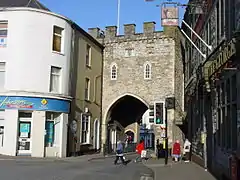 |
| Treowen | Mitchel Troy | 1 May 1952 | SO4615311109 51°47′46″N 2°46′56″W |
House | About 4.5 km (2.8 mi) west south west of Monmouth and 1 km (0.62 mi) north north east of Dingestow church, prominently situated amidst its own parkland just north of the road between Dingestow and Wonastow[85] | 2065 |  |
| Usk Castle | Usk | 16 February 1953 | SO3767701089 51°42′18″N 2°54′12″W |
Castle | On a spur on the hillside a short distance north east of the town[86] | 2127 |  |
| White Castle | Llantilio Crossenny | 19 November 1953 | SO3795616754 51°50′45″N 2°54′07″W |
Castle | Overlooking Llanvetherine, some 3 km (1.9 mi) north west of village of Llantilio Crossenny[87] | 2079 | 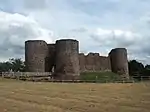 |
See also
- Listed buildings in Wales
- Grade I listed buildings in Herefordshire
- Grade I listed buildings in Forest of Dean
- Grade I listed buildings in Newport
- Grade I listed buildings in Torfaen
- Grade II* listed buildings in Blaenau Gwent – there are currently no Grade I listed buildings in Blaenau Gwent
- Grade I listed buildings in Powys
- Grade II* listed buildings in Monmouthshire
- Scheduled Monuments in Monmouthshire
Notes
- The British Listed Buildings online (BLBO) site records 54 listed buildings, as it has two entries for the Old Wye Bridge, Chepstow. It is not uncommon for bridges to have two listings when, as at Chepstow, one end of the bridge is in one country and the other in another. BLBO records the listing for the English end of the bridge (Entry 8, HE 1101561) as 'Chepstow Bridge', and the listing for the Welsh end (Entry 47, Cadw 2479) as 'Road Bridge over River Wye'.
- The sentences were subsequently commuted to transportation for life.
- Sometimes known as OSGB36, the grid reference is based on the British national grid reference system used by the Ordnance Survey.
References
- Evans 1953, p. 29.
- "Clause 256 (Hansard, 20 July 1972)". api.parliament.uk. HMSO. Retrieved 30 July 2019.
- Clark 1979, p. 207.
- Clark 1980, p. 42.
- "Monmouthshire – History, Facts, & Points of Interest". Encyclopedia Britannica. Retrieved 30 July 2019.
- "Monmouthshire Population". population.city. Retrieved 19 July 2019.
- "Coflein". online database of RCAHMW. Royal Commission on the Ancient and Historical Monuments of Wales. Retrieved 28 November 2016.
- "Planning (Listed Buildings and Conservation Areas) Act 1990". The National Archives. Retrieved 18 June 2013.
- "Historic England - Listed Buildings". historicengland.org.uk. Retrieved 18 August 2019.
- British Listed Buildings online. "Grade I Listed Buildings in Monmouthshire". www.britishlistedbuildings.co.uk. Retrieved 4 April 2019.
- Jenkins 2008, p. 163.
- Jenkins 2008, p. 169.
- Jenkins 2008, p. 174.
- Hayman 2016, p. 69.
- Newman 2000, p. 120.
- Tyerman & Warner 1951, p. 3.
- Mitchell 2010, pp. 65–74.
- Hando 1944, p. 15.
- Hando 1951, p. 82.
- Hando 1958, pp. 118-120.
- Hando 1954, pp. 55–57.
- Aslet 2005, p. 426.
- Kenyon 2010, p. 67.
- Clark 1953, p. 65.
- "An introduction to 'Tintern Abbey'". The British Library. Retrieved 20 July 2019.
- "Walter Savage Landor 1775 TO 1864". Brecon Beacons Parks Society. Retrieved 20 July 2019.
- Coxe 1995b, p. 210.
- Aslet 2005, pp. 427–428.
- "Charles Rolls – The Life of the Motoring and Aviation Pioneer". www.rolls-royceandbentley.co.uk. Rolls-Royce. Retrieved 19 July 2019.
- Coxe 1995a, Preface.
- Bradney 1991, preface.
- Fox & Raglan 1994, preface.
- Smith 1975, p. 7.
- Newman 2000, p. 84.
- Cadw. "Abbey Hotel (1940)". National Historic Assets of Wales. Retrieved 19 July 2019.
- Cadw. "Abergavenny Castle (2376)". National Historic Assets of Wales. Retrieved 19 July 2019.
- Cadw. "Court Farm Barn (1941)". National Historic Assets of Wales. Retrieved 19 July 2019.
- Cadw. "Caldicot Castle (2006)". National Historic Assets of Wales. Retrieved 19 July 2019.
- Cadw. "Castle House, Usk (2128)". National Historic Assets of Wales. Retrieved 19 July 2019.
- Cadw. "Chepstow Castle (2475)". National Historic Assets of Wales. Retrieved 19 July 2019.
- Cadw. "Church of St Aeddan, Bettws Newydd (1962)". National Historic Assets of Wales. Retrieved 19 July 2019.
- Cadw. "Church of St Bridget, Skenfrith (2082)". National Historic Assets of Wales. Retrieved 19 July 2019.
- Cadw. "Church of St Cadoc, Llangattock Lingoed (1955)". National Historic Assets of Wales. Retrieved 19 July 2019.
- Cadw. "Church of St David, Llangeview (2711)". National Historic Assets of Wales. Retrieved 19 July 2019.
- Cadw. "Church of St David, Llanthony (1938)". National Historic Assets of Wales. Retrieved 19 July 2019.
- Cadw. "Church of St Jerome, Llangwm (2028)". National Historic Assets of Wales. Retrieved 19 July 2019.
- Cadw. "Church of St John, Llandenny (17425)". National Historic Assets of Wales. Retrieved 19 July 2019.
- Cadw. "Church of St Martin, Cwmyoy (1933)". National Historic Assets of Wales. Retrieved 19 July 2019.
- Cadw. "Priory Church of St Mary, Abergavenny (2373)". National Historic Assets of Wales. Retrieved 19 July 2019.
- Cadw. "Church of St Mary, Caldicot (2019)". National Historic Assets of Wales. Retrieved 19 July 2019.
- Cadw. "Church of St Mary, Chepstow (2594)". National Historic Assets of Wales. Retrieved 19 July 2019.
- Cadw. "Church of St Mary the Virgin, Llanfair Kilgeddin (2782)". National Historic Assets of Wales. Retrieved 19 July 2019.
- Cadw. "Church of St Mary, Magor (2928)". National Historic Assets of Wales. Retrieved 19 July 2019.
- Cadw. "Church of St Mary, Portskewett (2044)". National Historic Assets of Wales. Retrieved 19 July 2019.
- Cadw. "Church of St Michael and All Angels, Gwernesney (2715)". National Historic Assets of Wales. Retrieved 19 July 2019.
- Cadw. "Church of St. Nicholas, Grosmont (1947)". National Historic Assets of Wales. Retrieved 19 July 2019.
- Cadw. "Church of St Nicholas, Trellech (2106)". National Historic Assets of Wales. Retrieved 19 July 2019.
- Cadw. "Church of St Peter, St Paul and St John, Llantrisant (2718)". National Historic Assets of Wales. Retrieved 19 July 2019.
- Cadw. "Church of St Teilo, Llantilio Crossenny (2073)". National Historic Assets of Wales. Retrieved 19 July 2019.
- Cadw. "Church of St Teilo, Llantilio Pertholey (2002)". National Historic Assets of Wales. Retrieved 19 July 2019.
- Cadw. "Church of St Tewdric, Mathern (2040)". National Historic Assets of Wales. Retrieved 19 July 2019.
- Cadw. "Church of St Tysoi, Llansoy (2029)". National Historic Assets of Wales. Retrieved 19 July 2019.
- Cadw. "Clytha Castle (1968)". National Historic Assets of Wales. Retrieved 19 July 2019.
- Cadw. "Clytha Park (1966)". National Historic Assets of Wales. Retrieved 19 July 2019.
- Cadw. "Cross at Croes Llwyd Farm, Raglan (24716)". National Historic Assets of Wales. Retrieved 19 July 2019.
- Cadw. "Great Castle House (2217)". National Historic Assets of Wales. Retrieved 19 July 2019.
- Cadw. "Grosmont Castle (1949)". National Historic Assets of Wales. Retrieved 19 July 2019.
- Cadw. "Llanthony Priory (1939)". National Historic Assets of Wales. Retrieved 19 July 2019.
- Cadw. "Llanvihangel Court (1919)". National Historic Assets of Wales. Retrieved 19 July 2019.
- Cadw. "Stable Block at Llanvihangel Court (19288)". National Historic Assets of Wales. Retrieved 19 July 2019.
- Cadw. "Llwyn-celyn Farmhouse (1937)". National Historic Assets of Wales. Retrieved 19 July 2019.
- Cadw. "Mathern Palace (2007)". National Historic Assets of Wales. Retrieved 19 July 2019.
- Cadw. "Monmouth Castle (2216)". National Historic Assets of Wales. Retrieved 19 July 2019.
- Cadw. "Monnow Bridge (2218)". National Historic Assets of Wales. Retrieved 19 July 2019.
- Cadw. "Pen-y-Clawdd Court (1926)". National Historic Assets of Wales. Retrieved 19 July 2019.
- Cadw. "Penallt Old Church (2104)". National Historic Assets of Wales. Retrieved 19 July 2019.
- Cadw. "Chepstow Port Wall (2477)". National Historic Assets of Wales. Retrieved 19 July 2019.
- Cadw. "Church of St Mary, Usk (2123)". National Historic Assets of Wales. Retrieved 19 July 2019.
- Cadw. "Priory Gatehouse (2126)". National Historic Assets of Wales. Retrieved 19 July 2019.
- Cadw. "Raglan Castle (2101)". National Historic Assets of Wales. Retrieved 19 July 2019.
- Cadw. "Old Wye Bridge (2479)". National Historic Assets of Wales. Retrieved 19 July 2019.
- Cadw. "Shire Hall, Monmouth (2228)". National Historic Assets of Wales. Retrieved 19 July 2019.
- Cadw. "Tintern Abbey (20437)". National Historic Assets of Wales. Retrieved 19 July 2019.
- Cadw. "Chepstow Town Gate (2476)". National Historic Assets of Wales. Retrieved 19 July 2019.
- Cadw. "Treowen House (2065)". National Historic Assets of Wales. Retrieved 19 July 2019.
- Cadw. "Usk Castle (2127)". National Historic Assets of Wales. Retrieved 19 July 2019.
- Cadw. "White Castle (2079)". National Historic Assets of Wales. Retrieved 19 July 2019.
Sources
- Aslet, Clive (2005). Landmarks of Britain. London: Hodder & Stoughton. ISBN 978-0-34073-5107.
editions:O60YB-B7LYMC.
- Bradney, Joseph (1991). A History of Monmouthshire: The Hundred of Skenfrith, Volume 1 Part 1. London: Academy Books. ISBN 978-1-87336-1092. OCLC 669714197.
- Clark, Arthur (1953). Raglan Castle and the Civil War in Monmouthshire. Newport: Newport & Monmouthshire Branch of the Historical Association and Chepstow Society. OCLC 249172228.
- — (1980). The Story of Monmouthshire, Volume 1, From the earliest times to the Civil War. Monmouth: Monnow Press. ISBN 978-0-95066-1810. OCLC 866777550.
- — (1979). The Story of Monmouthshire, Volume 2, From the Civil War to Present Times. Monmouth: Monnow Press. ISBN 978-0-95066-1803. OCLC 503676874.
- Coxe, William (1995) [1801]. An Historical Tour of Monmouthshire: Volume 1. Cardiff: Merton Priory Press. ISBN 978-1-8989-3709-8. OCLC 34476778.
- — (1995) [1801]. An Historical Tour of Monmouthshire: Volume 2. Cardiff: Merton Priory Press. ISBN 978-1-8989-3708-1. OCLC 34476778.
- Evans, Cyril James Oswald (1953). Monmouthshire: Its History and Topography. Cardiff: William Lewis Printers. OCLC 2415203.
- Fox, Cyril; Raglan, Lord (1994). Medieval Houses. Monmouthshire Houses. 1. Cardiff: Merton Priory Press Ltd & The National Museum of Wales. ISBN 978-0-72000-3963. OCLC 916186124.
- Hando, Fred (1944). The Pleasant Land of Gwent. Newport: R. H. Johns Ltd. OCLC 2534151.
- — (1951). Journeys in Gwent. Newport: R. H. Johns Ltd. OCLC 30202753.
- — (1954). Monmouthshire Sketch Book. Newport: R. H. Johns Ltd. OCLC 30166792.
- — (1958). Out and About in Monmouthshire. Newport: R. H. Johns Ltd. OCLC 30235598.
- Hayman, Richard (2016). Wye. Woonton Almeley: Logaston Press. ISBN 978-1-91083-9096.
- Jenkins, Simon (2008). Wales: Churches, Houses, Castles. London: Penguin Books. ISBN 978-0-71399-8931.
- Kenyon, John (2010). The Medieval Castles of Wales. Cardiff: University of Wales Press. ISBN 978-0-708-32180-5. OCLC 828219275.
- Mitchell, Julian (2010). The Wye Tour And Its Artists. Woonton Almeley: Logaston Press. ISBN 978-1-90666-3322. OCLC 648769582.
- Newman, John (2000). Gwent/Monmouthshire. The Buildings of Wales. London: Penguin Books. ISBN 978-0-30009-6309.
- Smith, Peter (1975). Houses of the Welsh Countryside. London: Her Majesty's Stationery Office. ISBN 978-0-1170-04757. OCLC 868639211.
- Tyerman, Hugo; Warner, Sydney (1951). Arthur Mee (ed.). Monmouthshire. The King's England. London: Hodder & Stoughton. OCLC 764861.
| Wikimedia Commons has media related to Grade I listed buildings in Monmouthshire. |